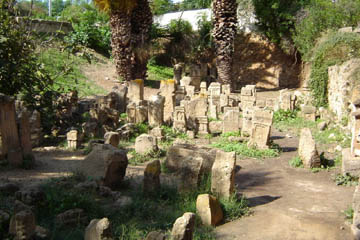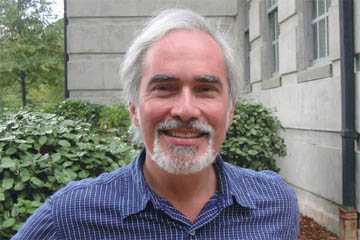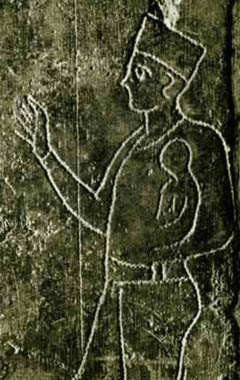Neonatal Bands and Human Sacrifices
Various ancient sources, among them the Bible, affirm that the worship of Baal frequently involved human sacrifice. Not only were the Canaanites guilty of this, but the Israelites themselves, when tempted away from their allegiance to Yahweh, sacrificed their children to Baal. The Valley of Hinnom, on the west of the Old City of Jerusalem, is particularly mentioned as the location where such ghastly sacrifices were offered.
Evidence in support of the documents has been found in several locations, most notably at Gezer, where a "tophet" was discovered. A row of eight standing stones stood over a "high place" where a large quantity of ashes marked the place of scrifice. Numerous pottery jars were found containing the bones of very young infants, giving Professor Macalister the clear impression that these babies had been sacrificed to the gods. You can see (and count) these stones for yourself on the NWTV website
However the one city singled out in the literature for the sacrifice of infants is Carthage, the Phoenician colony in north Africa. Roman authors describe how the wealthier parents of Carthage were in the habit of buying unwanted babies from poor people and substituting them for their own children in the ghastly sacrifices that went on there. They also claim that when the Romans landed in north Africa and laid siege to Carthage, the priests of Baal declared that Roman success was due to the gods' anger at this subterfuge. Terrified parents, anxious to do the best for their country, led grown children through the streets to the high place where they were sacrificed.

| |
| Stelae crowded together on the tophet of Carthage point to the large number of human sacrifices which took place on the site. |
The "tophet" at Carthage contains upwards of 20,000 urns containing the burned bones of children up to two years of age. The sheer scale of this slaughter has apalled many researchers, leading to suggestions that it is not sacrifice at all, merely a convenient burial place. The data has been interpreted in various ways.
For example, detailed study of the remains has shown that the number of burials increased at times of hardship. Those who believe that the ancient Carthaginians sacrificed their children point to this as evidence that the people were seeking the gods' favour by increased devoutness in sacrificing their children. Those who find it inconceivable that the Carthaginians - who must have been liberal Westerners like themselves - could have been so cruel, claim that in times of drought or famine there will naturally be higher child mortality, hence the greater number of burials.
The most recent study has analysed the sex of the children and finds that a large number of them were female. Professor Jeffrey Schwartz, of the Pitt's School of Arts and Sciences in the University of Pittsburgh, examined the contents of 348 urns and determined the time of death by the development of the bones and the neonatal line in teeth. The results were interesting.

| |
| Professor Jeffrey Schwartz, a physical anthropolgist whose main field of research and publication is in human evolutionary development. |
From those 348 urns they recovered 70 pelvises: 38 were definitely female, based on the sciatic notch, 26 definitely male, two were possibly female, one was possibly male, and three could not be determined. They claim that this is proof that the burials on the "tophet" were simply normal infant mortality, but in fact the evidence they have found does not bear this out. In normal infants the males are slightly weaker than the females and therefore more likely to die of natural causes. The preponderance of females - 40 to 27 - points to a sex bias which, while it may not be current among academic circles in Pittsburgh, is all too real in places like India and China, where females babies are either aborted or killed.
If you have to fulfil a religious duty by sacrificing a child, you will - if you are an Easterner - prefer to sacrifice a girl baby than a boy one. Provided the priest doesn't look too closely (and no doubt a suitably generous offering could ensure that) then you can go down in the record books as having fulfilled your duty and at the same time have got rid of an unwanted female!
Professor Schwartz then selected teeth from the 50 youngest babies and examined them for the neonatal band, which was present in only 24 of them, meaning that the majority had died either before birth or within two weeks of birth. Again, he interprets this as evidence that the Carthaginians didn't sacrifice their babies and again, the evidence can be interpreted differently.

| |
| A stele showing a Carthaginian priest holding a baby. The priest is usually interpreted as preparing to the sacrifice the infant. |
If you are going to sacrifice a baby, should you wait until the baby has grown and you have fallen in love with it, or should you do the deed as quickly as possible? The answer seems obvious, particularly as of the remaining 298 babies, the overwhelming majority died in their first year, the greater number aged only two to five months.
And that, perhaps, is the most convincing evidence that Prof Schwartz is wrong. Diphtheria, whooping cough, diorrhea and all the other childhood ailments that are responsible for so many Third World deaths have no favourite age at which to strike. Even if the "tophet" was restricted to babies who died in their first year, we would expect to find that every age between 1 and 12 months was more or less equally represented. This preponderance of two to five months points to some external factor bringing these young lives to a close at a particular time - perhaps at some developmental milestone such as weaning.
In addition there is the fact that adults and older children were buried in separate cemetaries also indicates that there was something special about these children. Unlike these other cemetaries, the "tophet" also contains the bones of animals, most easily explained by the practice of animal as well as human sacrifice, the burned remains of both being disposed of in a sacred area.
In short, however much it may outrage the liberal sensibilities of a Twenty-first Century professor of arts, the evidence from Carthage is still most easily and sensibly explained by accepting that when Plutarch, Tertullian, Orosius, Philo and Diodorus Siculus reported that the Carthaginians practised human sacrfice, those ancient historians were correct.
and count Various websites give the number of these standing stones as anything from seven to ten. The actual number is eight plus the "altar" stone, which may in fact have been a socket to hold a cult statue or a phallic symbol. Numerous plaques of Astarte, with her sexual organs exaggerated, and model phalli were found among the ashes, indicating that the high place was, as the Jewish prophets claimed, a centre of fertility worship and sexual activity. Return
neonatal line When a human baby is born there is an interruption in the production of enamel on the teeth. About two weeks after birth enamal starts to be laid down on the teeth again, but a microscopically thin opaque band forms during that crucial fortnight. Teeth without that band belong to babies that either died before birth or within two weeks of birth. Return
sciatic notch There are two indentations in the hip bone, one called the Lesser Sciatic Notch and the other, obviously, the Greater Sciatic Notch. When closed by ligaments, these notches form holes through which nerves can pass down to the leg.
The Greater Sciatic Notch can be used for sex determination. This is based, not on the width or depth of the notch but on the posterior angle and the length of the posterior segment. As far as I can tell, however, most of the work on this subject appears to have been done on adult bones and some have called in question the accuracy of such sex determination in infants and children. (See, for example, the article in the American Journal of Physical Anthropology.) This would seem to be yet another reason for doubting Dr Schwartz's assertions regarding this matter. (I am grateful to Victoria Huggett for drawing this to my attention.) Return
© Kendall K. Down 2010





